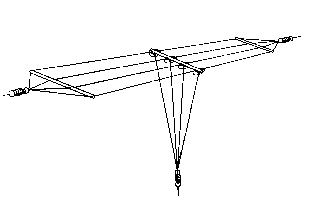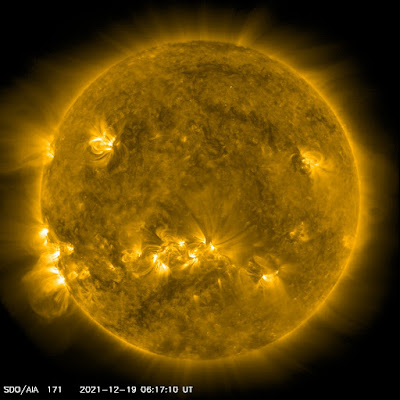It's holiday CLE time once again. This one is designed to take your mind from your troubles and enjoy a relaxing 10 day beacon hunt!
For example, 'AA' near Fargo, ND, transmitted on 365 kHz and its upper sideband CW identifier was tuned at 366.025 kHz while its lower sideband CW ident could be tuned at 363.946 kHz. Its USB tone was actually 1025 Hz while its LSB tone was 1054 Hz.
Often,
one sideband will be much stronger than the other so if you don't hear
the first one, try listening on the other sideband.
Canadian NDBs normally have an USB tone only, usually very close to 400 Hz. They also have a long dash (keydown) following the CW identifier.
All NDBs heard in North America will be listed in the RNA database (updated daily) while those heard in Europe may be found in the REU database. Beacons heard outside of these regions will be found in the RWW database. These databases have recently been re-vamped and are slicker than ever before!
From CLE organizers comes the following CLE info:
Hello all
Here are the final details for our holiday listening
event.
Please read this carefully to avoid
disappointment!
The task is to build a size 10 pyramid, with a
size 10 aerial on top.
We hope you will enjoy trying this challenge,
whether you are a beginner or have been an NDB listener for many years, and
whether you will have a lot of time, or rather little.
|
|
| Days: Saturday 25 Dec. to
Monday 3 Jan.
. / \ Times: Midday - Midday, your LOCAL
Time
/ \ Frequencies: 190 - 1740 kHz
/ \
Beacons: Normal NDBs (no UNIDs, DGPS, Navtex or
Amateur)
~~~~~~~~~~~~~~
You make your pyramid by logging
beacons from 19 different radio countries of your choice as
follows:
10 different NDBs from the country at the base of the
pyramid
9 NDBs from the next radio country
8 NDBs from the
third, etc.
- - - all the way to:
2 NDBs from the ninth
country at the top of the pyramid.
Finally, your pyramid needs a
vertical antenna on it! That is made by logging 10 extra NDBs, each one from
yet another different radio country.
An example of a completed
pyramid is given at the end of this email.
You can log the NDBs in any
time sequence, of course.
IMPORTANT The countries are the same
ones that we always use, defined in our Radio Countries List http://www.ndblist.info/ndbinfo/countrylist.pdf
Each
USA State, each Australian State and each Canadian Province is a separate radio
country.
* If you can't reach size 10, please still send your
log.
E.g. a size 7 would have 7 loggings for the base country, then 6,
5, 4, 3 and 2 loggings from five other different countries and, for the antenna,
a single logging from each of 7 yet other different
countries.
If you reach size 10, there is no need to stop there
- with enough time, you could go on and try to build your pyramid bigger and
higher by adding more loggings.
E.g. For a size 12 pyramid you would
need to log:
12 NDBs from one country and 11, 10, 9, 8, . to
2 loggings from10 other different countries
12 extra
loggings from 12 other different countries to make the
antenna.
You can get a lot of help in planning your listening
from the Rxx database https://rxx.classaxe.com/rww/signals
The 'Help' option explains how you can make very powerful enquiries in
the Database.
LOGS: We suggest that you show your
loggings in pyramid order. E.g., if you choose top-to-bottom, show each of
the '1' loggings first (forming the aerial), then the '2', then the '3', then
'4', '5', etc. with just an extra blank line to separate the loggings from
different radio countries. There's no need to add any text to describe the
levels in your pyramid because the Harvester Software will work that out
automatically.
Please include for every logging:
#
the UTC date ( e.g. '2021-12-25', etc. )*
# UTC time (the day
changes at 00:00 UTC).
# kHz - the NDB's nominal, published,
frequency.
# Call Ident.
Show those main log items
FIRST. Other details, such as country, location, etc., go LATER on the same
line. Do be careful that each of your NDBs really is associated with the radio
country you intended.
*If you have made any loggings in January
and also in December (by UTC time) we ask you please NOT to use the simple 'dd'
date format (that can make difficulties for the good people who enter logs into
the RXX database)
UNIDs, though not suitable for this CLE,
could be shown in a SEPARATE section of your log, together with other
interesting loggings that didn't fit into your pyramid.
Please
post your 'Final' log to the List, preferably as a Plain Text email (not in an
attachment) using 'CLE275' and 'FINAL' in its title. We'll send an 'Any More
Logs?' email at about 18:00 UTC on TUESDAY 4th Jan. so you can check that
your log has been found OK. Do make sure that it has arrived on the List by
09:00 UTC on WEDNESDAY 5th Jan. at the very latest.
We hope to finish
making the combined results within two or three days.
The size
of our pyramids will depend a lot on where each of us happens to be located. If
you are unlucky there, why not try listening via a suitable remote receiver that
gives good NDB listening?
You could use any one remote receiver for
your loggings, stating its location and owner - with their permission
if required.
A remote listener may NOT also use another receiver,
whether
Local or remote, to obtain further loggings for a
CLE.
As with all our CLEs, this is intended to be an educational
and 'fun' event
- it's not a contest!
Enjoy your listening - you may
find it quite addictive this time!
The COVID difficulties have
made things really hard for most of us, but maybe a bit of pyramid-building will
provide a safe and relaxing escape for a while!
Joachim and I hope you
have a very Happy Christmas and many good things during
2022.
73
Brian and
Joachim
--------------------------------------------------------------------
From:
Brian Keyte G3SIA ndbcle'at'ndblist.info
Location: Surrey, SE
England (CLE
coordinator)
---------------------------------------------------------------------
Here
is an imaginary example of a pyramid with its antenna,
maybe for a
listener in British Columbia (BC).
Each B is a different
Beacon:
B GRL 1
ndb
B PTR 1 ndb
B AZ 1
ndb
B NE 1
ndb
B IA 1
ndb
B NT 1
ndb
B CA 1
ndb
B CO 1
ndb
B NC 1
ndb
B ON 1
ndb
B B HWA 2
ndbs
B B B OR 3
ndbs
B B B B MB 4
ndbs
B B B B B WA 5
ndbs
B B B B B B MT 6
ndbs
B B B B B B B SK 7
ndbs
B B B B B B B B ALS 8
ndbs
B B B B B B B B B BC 9
ndbs
B B B B B B B B B B AB 10
ndbs
These listening events serve several purposes. They
• determine, worldwide, which beacons are out-of-service or have gone silent since the last CLE covering this range
• will indicate the state of propagation conditions at the various participant locations
• will give you an indication of how well your LF/MF receiving system is working
• give participants a fun yet challenging activity to keep their listening skills honed
Final details can be found at the NDB List website, and worldwide results, for every participant, will be posted there a few days after the event.
The NDB List Group is a great place to learn more about the 'Art of NDB DXing' or to meet other DXers in your region. There is a lot of good information available there and new members are always very welcome. As well, you can follow the results of other CLE participants from night to night as propagation is always an active topic of discussion.
You need not be an NDB List member to participate in the CLEs and all reports, no matter how small, are of much value to the organizers.
Remember - 'First-time' logs are always VERY welcome!
Reports may be sent to the NDB List Group or e-mailed to CLE co-ordinator, Brian Keyte (G3SIA), whose address appears above. If you are a member of the group, all final results will also be e-mailed and posted there.
Please ... give the CLE a try ... then let us know what NDB's can be heard from your location! Your report can then be added to the worldwide database to help keep it up-to-date.
Have fun and good hunting!


